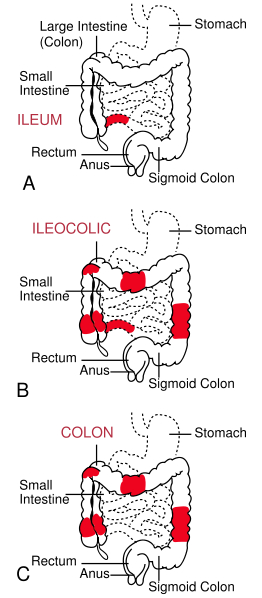Crohn's disease classification
|
Crohn's disease |
|
Diagnosis |
|---|
|
Treatment |
|
Case Studies |
|
Crohn's disease classification On the Web |
|
American Roentgen Ray Society Images of Crohn's disease classification |
|
Risk calculators and risk factors for Crohn's disease classification |
Editor-In-Chief: C. Michael Gibson, M.S., M.D. [1]
Classification
Crohn's disease almost invariably affects the gastrointestinal tract. As a result, most gastroenterologists classify the disease by the affected areas.
- Ileocolic Crohn's disease, which affects both the ileum (the last part of the small intestine that connects to the large intestine) and the large intestine, accounts for fifty percent of cases.
- Crohn's ileitis, affecting the ileum only, accounts for thirty percent of cases.
- Crohn's colitis, affecting the large intestine, accounts for the remaining twenty percent of cases, and may be particularly difficult to distinguish from ulcerative colitis.
The disease can attack any part of the digestive tract, from mouth to anus. However, individuals affected by the disease rarely fall outside these three classifications, being affected in other parts of the gastrointestinal tract such as the stomach and esophagus.
Crohn's disease may also be classified by the behavior of disease as it progresses. This was formalized in the Vienna classification of Crohn's disease.[1] There are three categories of disease presentation in Crohn's disease:
- Stricturing disease causes narrowing of the bowel which may lead to bowel obstruction or changes in the caliber of the feces.
- Penetrating disease creates abnormal passageways (fistulae) between the bowel and other structures such as the skin.
- Inflammatory disease (or non-stricturing, non-penetrating disease) causes inflammation without causing strictures or fistulae.[1][2]
 |
 |
References
- ↑ 1.0 1.1 Gasche C, Scholmerich J, Brynskov J, D'Haens G, Hanauer S, Irvine E, Jewell D, Rachmilewitz D, Sachar D, Sandborn W, Sutherland L (2000). "A simple classification of Crohn's disease: report of the Working Party for the World Congresses of Gastroenterology, Vienna 1998". Inflamm Bowel Dis. 6 (1): 8–15. PMID 10701144.
- ↑ Dubinsky MC, Fleshner PP. (2003). "Treatment of Crohn's Disease of Inflammatory, Stenotic, and Fistulizing Phenotypes". Curr Treat Options Gastroenterol. 6 (3): 183–200. PMID 12744819.